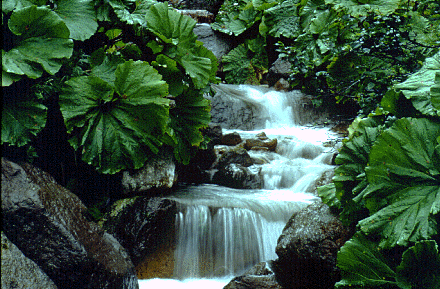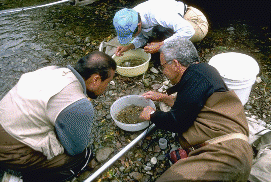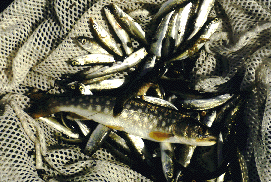
![]()
![]()
Project Management Plan |
| Sampling protocol.--Because we are limited by weather to
an extremely short annual field season (eight weeks maximum), all
collecting efforts must be highly efficient and well planned in advance.
On each island, scientists will lay out and collect at intervals along a
set of transects that coincide with streams and/or rivers. While
operating on the assumption that the greatest diversity will occur within and
adjacent to aquatic habitats, we recognize that confining our efforts
to wet transects will not result in complete biotic coverage. It would
be good to collect along dry transects as well, but because of the
severe time constraints mandated by the weather, we are forced to
choose a subset of possibilities rather than attempt to "do it all."
Some collecting, particularly in lakes and by those assigned to terrestrial
taxa (vascular plants, spiders, reptiles, birds, and mammals), will occur
outside of the transects but, in all cases, strict protocols for
data acquisition will be followed.
|
 Petasites japonicus var. giganteus (Asteraceae) along small falls on Ketoi Island.
|
 The transects will
extend from lowlands to the greatest possible elevations, starting where
sandy or rocky intertidal ends and vegetation begins, and terminating, in
some cases, where volcanic activity precludes human presence. Collecting
centers will be established at 200-m intervals along each transect. From
each collecting center, equal effort will be made to collect within a
2-hectare area, i.e., within a rectangle that extends 100 m above, 100 m
below, and 50 m to each side of the collecting center. Islands with
elevations of less than 200 m will be collected along stream or river
transects that pass through each island at its greatest possible length.
Survey methods will remain as consistent as possible under varying field
conditions so that within and between island localities can be compared
directly. The transects will
extend from lowlands to the greatest possible elevations, starting where
sandy or rocky intertidal ends and vegetation begins, and terminating, in
some cases, where volcanic activity precludes human presence. Collecting
centers will be established at 200-m intervals along each transect. From
each collecting center, equal effort will be made to collect within a
2-hectare area, i.e., within a rectangle that extends 100 m above, 100 m
below, and 50 m to each side of the collecting center. Islands with
elevations of less than 200 m will be collected along stream or river
transects that pass through each island at its greatest possible length.
Survey methods will remain as consistent as possible under varying field
conditions so that within and between island localities can be compared
directly.
|
 In addition to
collecting along transects, those assigned to insects (aquatic taxa),
freshwater mollusks, and fishes will collect in as many lakes as
possible, with equal sampling effort at varying elevations. We will
limit ourselves to no more than nine days per transect (many can be
adequately collected in as few as five days), thus allowing six or seven
transects to be covered within a single field season of 60 days, and a
total of no more than 35 transects within the five-year life of the
project. The field work will be more-or-less divided equally over the
five years (see "Project Schedule"). In addition to
collecting along transects, those assigned to insects (aquatic taxa),
freshwater mollusks, and fishes will collect in as many lakes as
possible, with equal sampling effort at varying elevations. We will
limit ourselves to no more than nine days per transect (many can be
adequately collected in as few as five days), thus allowing six or seven
transects to be covered within a single field season of 60 days, and a
total of no more than 35 transects within the five-year life of the
project. The field work will be more-or-less divided equally over the
five years (see "Project Schedule").
|


 Sampling aquatic insects in a tributary of the Rikorda River (Kunashir); a collection of fishes taken by seine on Kunashir.
|
 Animals will be
collected as follows: lake-dwelling insects and mollusks by small grabs
and cores, deployed by hand from shore and by inflatables ("Zodiacs")
offshore; stream-dwelling insects and mollusks by hand and with push
nets; terrestrial mollusks by time constrained searches on trunks and
branches of trees, in leaf litter, and in other appropriate cover; spiders
by pitfall traps and by constrained searches; freshwater fishes by seine,
gill and dip nets, electroshockers, and biodegradable ichthyocides;
amphibians and reptiles with pitfall traps and by time constrained
searches in appropriate cover by day and night (fossorial species by
digging and trenching); birds will be shot or captured with mist nets;
terrestrial mammals by shooting and by kill and pitfall traps; bats with
mist nets. Pitfall traps and nets will be checked after dusk, at
midnight, and again at sunrise. All incidentally captured animals (i.e.,
those outside selected taxa) will be preserved and brought back for
archival storage in appropriate museum collections. In all cases, quick
and reasonably painless means of euthanasia will be used. Animals will be
collected as follows: lake-dwelling insects and mollusks by small grabs
and cores, deployed by hand from shore and by inflatables ("Zodiacs")
offshore; stream-dwelling insects and mollusks by hand and with push
nets; terrestrial mollusks by time constrained searches on trunks and
branches of trees, in leaf litter, and in other appropriate cover; spiders
by pitfall traps and by constrained searches; freshwater fishes by seine,
gill and dip nets, electroshockers, and biodegradable ichthyocides;
amphibians and reptiles with pitfall traps and by time constrained
searches in appropriate cover by day and night (fossorial species by
digging and trenching); birds will be shot or captured with mist nets;
terrestrial mammals by shooting and by kill and pitfall traps; bats with
mist nets. Pitfall traps and nets will be checked after dusk, at
midnight, and again at sunrise. All incidentally captured animals (i.e.,
those outside selected taxa) will be preserved and brought back for
archival storage in appropriate museum collections. In all cases, quick
and reasonably painless means of euthanasia will be used.
Specimen curation and disposition.--All collected material will be packaged appropriately and stored aboard ship for transporation to post-expedition curatorial facilities set up ahead of time at Usujiri Biological Station, Hokkaido University, Hakodate. Collections will then be sorted, identified to the extent possible, and otherwise curated. It is agreed by authorities of the host country (see "Collecting Permit") that whole-specimen collections, including primary type material, will be divided more or less equally among the three participating institutions. All tissue samples will be shipped to Seattle where they will be stored at the Frozen Tissue Archive of the Burke Museum. Storage facilities at the three institutions are excellent, and appropriate long-term care of all material is assured. |
|
Data acquisition and dissemination of information.--Precise locality
data will be recorded with a Global Positioning System (GPS); a
differential beacon receiver will be used to correct the slightly
inaccurate dithered output of commercial hand-held GPS receivers. Data
will be recorded in the field on standardized "Field Data Sheets,"
which will be linked to specimens by field numbers. While in the field
and at the Usujiri Biological Station, data will be entered on
high-powered DOS machines. Two such machines, maintained aboard the
research vessel during the field season and later transferred
temporarily to the Usujiri Biological Station, will accommodate the
volume of data entry anticipated. "Paradox" database management
software, employing customized data entry screens designed to match the
layout of the "Field Data Sheets," will be used for initial data entry
and editing.
|
![]()